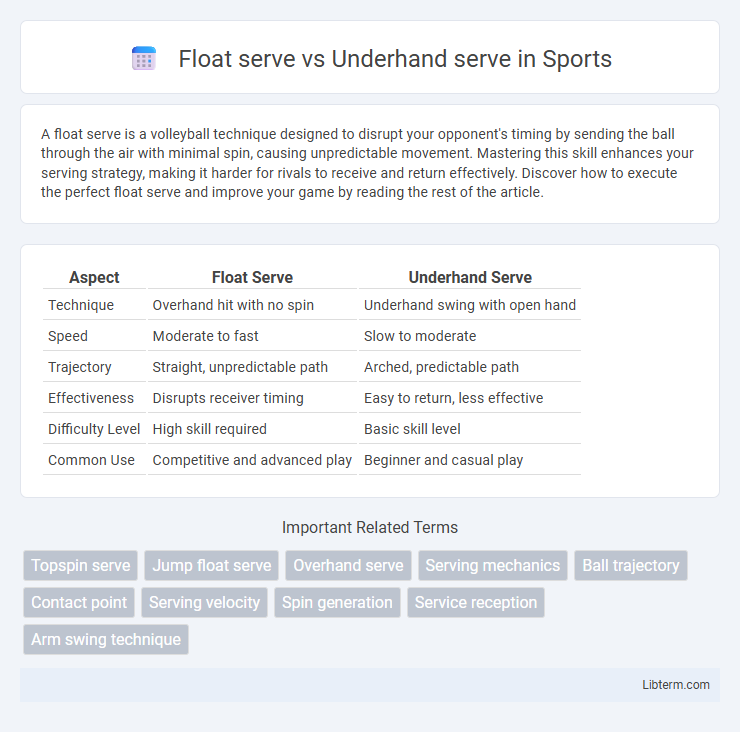A float serve is a volleyball technique designed to disrupt your opponent's timing by sending the ball through the air with minimal spin, causing unpredictable movement. Mastering this skill enhances your serving strategy, making it harder for rivals to receive and return effectively. Discover how to execute the perfect float serve and improve your game by reading the rest of the article.
Table of Comparison
| Aspect | Float Serve | Underhand Serve |
|---|---|---|
| Technique | Overhand hit with no spin | Underhand swing with open hand |
| Speed | Moderate to fast | Slow to moderate |
| Trajectory | Straight, unpredictable path | Arched, predictable path |
| Effectiveness | Disrupts receiver timing | Easy to return, less effective |
| Difficulty Level | High skill required | Basic skill level |
| Common Use | Competitive and advanced play | Beginner and casual play |
Introduction to Volleyball Serve Techniques
Float serve generates unpredictable ball movement by minimizing spin, creating a challenging trajectory for opponents, whereas the underhand serve offers greater control and consistency through a simple, upward motion of the arm. Volleyball serve techniques influence game dynamics by balancing power, precision, and difficulty faced by receivers. Mastery of both serves enhances a player's versatility and strategic options during competitive play.
What is a Float Serve?
A float serve is a type of volleyball serve characterized by its unpredictable, non-spinning trajectory that causes the ball to move erratically in the air, making it difficult for opponents to predict and receive. Unlike the underhand serve, which uses a smooth, controlled motion with minimal ball movement, the float serve relies on striking the ball in a way that minimizes spin and maximizes aerodynamic forces. This serve is favored for its ability to disrupt the opponent's passing rhythm and increase the chance of service errors.
What is an Underhand Serve?
An underhand serve in volleyball is executed by swinging the arm in a low arc beneath the waist to strike the ball, offering greater control and accuracy compared to more aggressive serves. This technique is often preferred by beginners or in recreational play due to its simplicity and consistency. Unlike the float serve, which generates unpredictable ball movement through a firm, overhand hit, the underhand serve emphasizes a smooth, stable trajectory for easier reception by teammates.
Key Differences: Float Serve vs Underhand Serve
The float serve generates unpredictable ball movement through minimal spin, making it harder for opponents to receive, whereas the underhand serve emphasizes ease and control with a gentle toss and straightforward contact. Float serves typically require more advanced technique and wrist snap to create the floating effect, while underhand serves are simpler, relying on a swing from below the waist. In competitive volleyball, float serves are preferred for their deceptive trajectory, contrasting with underhand serves often used by beginners or in casual play for consistency.
Technique Breakdown: Executing a Float Serve
The float serve technique involves striking the volleyball with a firm, open hand to produce a ball that moves unpredictably through the air due to minimal spin. Key steps include tossing the ball slightly in front of the hitting shoulder, making contact with the middle of the palm, and snapping the wrist at impact to create a stable, knuckleball effect. Mastery of this serve requires precise hand positioning and consistent ball toss to maximize the float's erratic movement, challenging the receiver's timing.
Technique Breakdown: Executing an Underhand Serve
The underhand serve begins with a relaxed grip on the volleyball and a consistent, controlled toss slightly in front of the hitting shoulder. The server strikes the ball with the heel of the palm, maintaining a straight arm to produce a low, accurate trajectory that typically clears the net with minimal spin. This technique contrasts with the float serve, which requires a more forceful strike to create an unpredictable, non-rotating flight path.
Advantages of Using a Float Serve
The float serve offers a significant advantage in volleyball due to its unpredictable trajectory and minimal spin, making it difficult for opponents to accurately judge and receive the ball. This serve generates sudden movement in the air, disrupting the timing and positioning of the receiving team, often leading to reception errors or weak returns. Its effectiveness is enhanced by its relative ease of execution compared to the underhand serve, which generally provides less power and predictability, reducing offensive opportunities.
Advantages of Using an Underhand Serve
The underhand serve offers greater control and accuracy, making it ideal for beginner and intermediate volleyball players who need consistent ball placement. Its easier execution reduces the risk of faults like serving out of bounds or into the net, enhancing overall game confidence. This serve style also allows players to maintain better balance and readiness for defense immediately after serving.
When to Use Float Serve vs Underhand Serve
Use a float serve when aiming to create unpredictable ball movement and challenge the receiver's timing with minimal spin, making it ideal for advanced players seeking aggressive serve strategies. Choose an underhand serve for consistent, controlled serve delivery, especially suited for beginners or in casual play where accuracy and ease of execution are prioritized. Selecting between float and underhand serves depends on the player's skill level and the desired impact on the opponent's reception.
Which Serve Is Best for Beginners and Pros?
The underhand serve is ideal for beginners due to its simplicity, control, and lower risk of errors, enabling players to build confidence and consistency in serving. Float serves, preferred by advanced players, produce unpredictable ball movement by minimizing spin, challenging opponents and adding tactical advantage in competitive matches. Mastery of the underhand serve establishes a solid foundation while the float serve enhances offensive strategies, making each serve suitable at different skill levels.
Float serve Infographic

 libterm.com
libterm.com